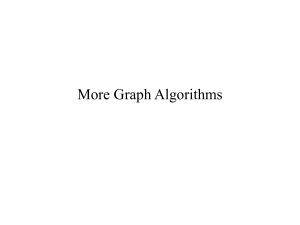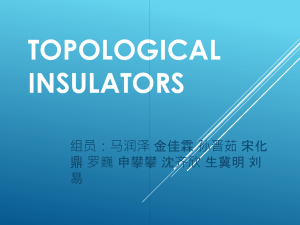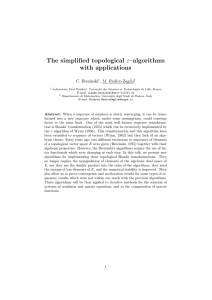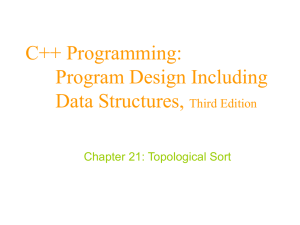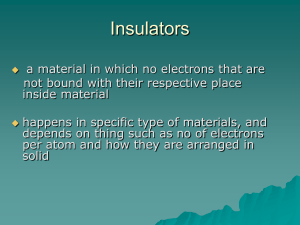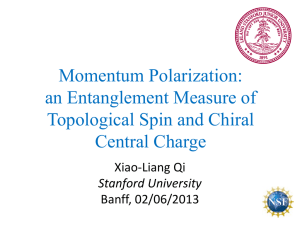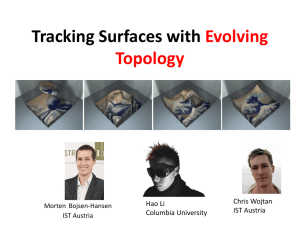Anyons & Topological Quantum Computation
advertisement
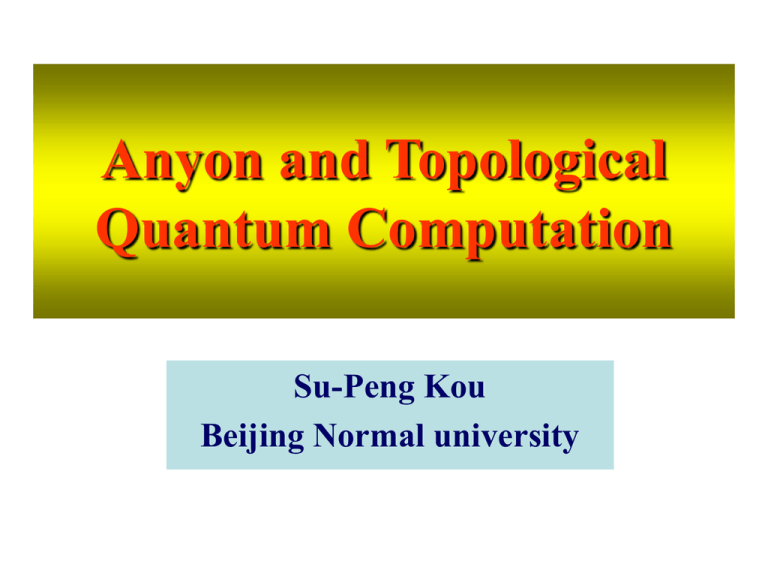
Anyon and Topological Quantum Computation Su-Peng Kou Beijing Normal university Outline 1. Part I: Anyons and braiding group 2. Part II: Quantum computation of topological qubits in Z2 topological orders 3. Part III : Topological quantum computation by Ising anyons 4. IV: Topological quantum computation by Fibonacci anyons Key words: topological string operator, nonAbelian anyon Milestone for topological quantum computation 1997, Kitaev proposed the idea of topological quantum bit and fault torrent quantum computation in an Abelian state. 2001, Kitaev proposed the topological quantum compuation by braiding nonAbelian anyons. 2001, Preskill, Freedman and others proposed a universal topological quantum computation. (I) Anyons and braid groups Boson b1 , b2 b2 , b1 Fermion f1 , f 2 f 2 , f1 Abelian statistics via non-Abelian statistics Abelian anyon 1 , 2 e i 2 , 1 , 0, non Abelian anyon 1 , 2 M 2 , 1 , M is a matrix Example (toy model) of Abelian Anyons : charge q - flux Φ composites (Wilczek, '82) The Aharonov - Bohm phase qΦ E.g. for q e, Φ 2/ne, the statistica l angle π/n. Exchange statistics and braid group Particle Exchange : world lines braiding Braid group [ i , k ] 0 i |i k | 2 i2 1 k i i 1 Yang - Baxter i 1 i i i 1 i i 1 i i 1 General anyon theory 1. A finite set of quasi-particles or anyonic “charges.” 2. Fusion rules (specifying how charges can combine or split). 3. Braiding rules (specifying behavior under particle exchange). 1. Fusion rules : N matrix ab N c c ab c 2. Braiding rules: R matrix b a a b R ab c 3. Associativity relations for fusion: F matrix [F f abc d ] ef Pentagon equation: Hexagon equation: Non-Abelian statistics Exchanging particles 1 and 2: Exchanging particles 2 and 3: • Matrices M12 and M23 don’t commute; • Matrices M form a higher-dimensional representation of the braid-group. (II) Quantum computation of topological qubits in Z2 topological orders 1. Z2 topological order 1. There are four sectors : I (vacuum), ε(fermion), e (Z2 charge), m (Z2 vortex) ; 2. Z2 gauge theory 3. U(1)×U(1) mutual Chern-Simons theory 4. Topological degeneracy : 4 on torus SP Kou, M Levin, and XG Wen, PRB 78, 155134 (2008). Mutual semion statistics between Z2 vortex and Z2 charge Z2 charge Z2 vortex flux Mutual Flux binding Fermion as the bound state of a Z2 vortex and a Z2 charge Fusion rule A. Yu. Kitaev, Ann. Phys. 303, 2 2003. Toric-code model AS A.Y.Kitaev,Annals Phys. 303, 2 (2003) BP Wen-plaquette model H g Fˆ i , i x y x y Fˆ i i i eˆ x i eˆ x eˆ y i eˆ y X. G. Wen, PRL. 90, 016803 (2003) y x x y Solving the Wen-plaquette model x y x y H g Fˆi , Fˆi i i eˆx i eˆx eˆ y i eˆ y i • The energy eigenstates are labeled by the eigenstates of Fˆi Fˆ , H 0 Fˆ , Fˆ 0 i • Because of 2 Fˆi 1 , i j the eigenvalues are Fi 1 and Fi 1 The energy gap x y x y H g Fˆi , Fˆi i i eˆx i eˆx eˆ y i eˆ y i • For g>0, the ground state is Fi 1 1 1 1 1 1 1 1 1 1 -1 1 1 1 1 1 1 1 1 The ground state energy is E0=Ng The elementary excitation is Fi 1 The energy gap for it becomes E1 E 0 2 g , for Fi 1 The statistics for the elementary excitations • There are two kinds of Bosonic excitations: • Z2 vortex F 1 ii x i y even • Z2 charge Fiix i y odd 1 • Each kind of excitations moves on each subplaquette: • Why? -1 1 1 1 1 1 1 1 1 -1 1 1 1 1 1 1 1 1 • There are two constraints (the even-by-even lattice): One for the even plaquettes, the other for the odd plaquettes ii x i y even Fiix i y even 1 Fiix i y odd 1 ii x i y odd • The hopping from even plaquette to odd violates the constraints : You cannot change -1 1 1 1 -1 a Z2 vortex into a Z2 charge 1 1 1 1 1 1 Topological degeneracy on a torus (even-by-even lattice) : • On an even-by-even lattice, there are totally N 2 states N Lx Ly 2 2 F 1 and F i 1 • Under the constaints, i i i even i i odd N 2 the number of states are only 4 • For the ground state Fi 1 , it must be four-fold degeneracy. x y x y The dynamics of the Z2 Vortex and Z2 charge • Z2 vortex (charge) can only move in the same subplaquette: • The hopping operators for Z2 vortex (charge) are x x i and y i x ˆ ˆ F i eˆ y i i eˆ y Fi y ˆ i Fi i Fˆi y The mutual semion statistics between the Z2 Vortex and Z2 charge • When an excitation (Z2 vortex) in even-plaquette move around an excitation (Z2 charge) in oddplaquette, the operator is F x y x y i i i eˆx i eˆ x eˆ y i eˆ y • it is -1 with an excitation on it Fi 1 • This is the character for mutual semion statistics Fermion as the bound state of a Z2 vortex and a Z2 charge. X. G. Wen, PRD68, 024501 (2003). mutual Controlling the hopping of quasi-particles by external fields • The hopping operators of Z2 vortex and charge are i x and i y • The hopping operator of fermion is iz So one can control the dynamics of different quasiparticles by applying different external. • Closed strings • Open strings String net condensation for the ground states The string operators: Wc C , Wv C和 W f C , For the ground state, the closed-strings are condensed The toric-code model H g Zi g ieven X i , Z i i i eˆx i eˆx eˆy i eˆy , z iodd X i i i eˆx i eˆx eˆ y i eˆ y x x x x • There are two kinds of Bosonic excitations: • Z2 vortex Z ii i even 1 • Z2 charge X ii i odd 1 x y x y Fermion as the bound state of a Z2 vortex and a Z2 charge. z z z Controlling the hopping of quasi-particles by external fields • The hopping operator of Z2 vortex is ix • The hopping operator of Z2 charge is iz • The hopping operator of fermion is iy So one can control the dynamics of different quasi-particles by applying different external fields. 2. Topological qubit A. Yu. Kitaev, Annals Phys. 303, 2 (2003) |0> and |1> are the degenerate ground-states of a (Z2) topological order due to the (non-trivial) topology. 0 1 Advantage No local perturbation can introduce decoherence. Ioffe, &, Nature 415, 503 (2002) Topology of Z2 topological order E E 1 Disc E 2 Cylinder 4 Torus Hole on a Disc Topological closed string operators on torus – topological qubits Degenerate ground states as eigenstates of topological closed operators • Algebra relationship: • Define pseudo-spin operators: Topological closed string operators • On torus,pseudo-spin representation of topological closed string operators: S.P. Kou, PHYS. REV. LETT. 102, 120402 (2009). J. Yu and S. P. Kou, PHYS. REV. B 80, 075107 (2009). S. P. Kou, PHYS. REV. A 80, 052317 (2009). Degenerate ground states as eigenstates of topological closed operators m1 , m2 m1 m2 zl ml ml, ml 0 zl ml ml. ml 1 zl (l 1, 2) Toric codes : topological qubits on torus There are four degenerate ground states for the Z2 topological order on a torus: m, n = 0, 1 label the flux into the holes of the torus. How to control the topological qubits? A. Y. Kitaev : “Unfortunately, I do not know any way this quantum information can get in or out. Too few things can be done by moving abelian anyons. All other imaginable ways of accessing the ground state are uncontrollable.” A.Y.Kitaev,Annals Phys. 303, 2 (2003) 3. Quantum tunneling effect of topological qubits : topological closed E representation E string Tunneling processes are virtual quasi-particle moves around the 1 periodic direction. Disc Cylinder Topological closed string operator as a virtual particle hopping Topological closed string operators may connect different degenerate ground states S.P. Kou, PHYS. REV. LETT. 102, 120402 (2009). J. Yu and S. P. Kou, PHYS. REV. B 80, 075107 (2009). S. P. Kou, PHYS. REV. A 80, 052317 (2009). Higher order perturbation approach 0 U 0, T exp i H t dt , I I iH iH 0t H 0t . H t e e I I j U 0, 0, |m U |m I I j0 j0 U 0, |m I 1 E 0 H 0 j H . I |m L1 E m,n n H 0, |m. I UI • Energy splitting : lowest order contribution of topological closed string operators E n H I E m,n 0 1 L 1 H . I 0 |m H0 L0 is the length of topological closed string operator # The energy splitting from higher order (degenerate) perturbation approach E n H I E m,n 0 1 L 1 H . I 0 |m 0 H t eff E L : Hopping steps of quasi-particles teff : Hopping integral : Excited energy of quasi-particles L J. Yu and S. P. Kou, PHYS. REV. B 80, 075107 (2009). # Topological closed string operators of four degenerate ground states for the Wen-plaquette model under x- and z-component external fields Effective model of four degenerate ground states for the Wen-plaquette model under xand z-component external fields External field along z direction • In anisotropy limit, the four degenerate ground states split two groups, Lx Ly , z z z z E 1 h h h 2, E2 2, E3 h2 和 E4 2。 z z E 1 E 3 2h 1 , E 1 E 2 2h 2 . 2×6 lattice on the Wenplaquette model under z direction field External field along z direction • Isotropy limit, Lx Ly , the four degenerate ground states split three groups z z E 1 E 2 0, E 3 2h 和 E 2h 4 1 1. 4×4 lattice on Wenplaquette model under zdirection External field along x direction • Under x-direction field, the four degenerate ground states split three groups: E 1 2J xx , E 2 2J xx , E 3 E 4 J zz 0, 4×4 lattice on Wenplaquette model under xdirection # Ground states energy splitting of Wen-plaqutte model on torus under a magnetic field along x-direction Ground states energy splitting of Wen-plaqutte model on torus under a magnetic field along z-direction Planar codes : topological qubits on surface with holes flux Fermionic based L. B. Ioffe, et al., Nature 415, 503 (2002). Effective model of the degenerate ground states of multi-hole S.P. Kou, PHYS. REV. LETT. 102, 120402 (2009). S. P. Kou, PHYS. REV. A 80, 052317 (2009). H eff J ij i j J ij i j hi i hi i z ij z z x ij x x z i z x x i The four parameters Jz, Jx, hx, hz are determined by the quantum effects of different quasi-particles. Unitary operations • A general operator becomes : U e i z e i x e i z H eff J ij i j J ij i j hi i hi i z ij z z x ij x x z i For example , Hadamard gate is z x i x CNOT gate and quantum entangled state of topological qubits S. P. Kou, PHYS. REV. A 80, 052317 (2009). III. Topological quantum computation by braiding Ising anyons Topological Quantum Computation Computation Physics output measure operation braid initialize create particles Eric Rowell (I) Ising anyons Particle type : I , , 1 Fusion rules: 1 Ising anyons Majorana fermion Another anyon flux σ:π-Flux binding a Majorana Fermion SU(2)2 non-Abelian statistics between π-flux with a trapped majorana fermion. px+ipy-wave superconductor : an example of symmetry protected topological order • µ>0, non-Abelian Topologial state • µ<0, Abelian Topologial state Read, Green, 2000. S. P. Kou and X.G. Wen, 2009. Winding number in momentum space BdG equation of px+ipy superconductor Bogoliubov deGennes Hamiltonian: Eigenstates in +/- E pairs Spectrum with a gap Excitations: Fermionic quasiparticles above the gap BdG equation of vortex in px+ipy superconductor E=0 Whyπ vortex in px+ipy wave superconductors traps majorona fermion? • The existence of zero mode in πflux for chiral superconducting state : cancelation between the π flux of vortex and edge chiral angle (winding numer in momentum space) • Majorana fermion in chiral p-wave – mixed annihilation operator and generation operation Chiral edge state Edge state y x Edge Majorana fermion p+ip superconductor Chiral fermion propagates along edge Edge state encircling a droplet Antiperiodic boundary condition Spinor rotates by 2π encircling sample Vortex (πflux) in px+ipy superconductor Single vortex E=0 Majorana fermion encircling sample : an encircling vortex - a “vortex zero mode” Fermion picks up π phase around vortex: Changes to periodic boundary condition E = nω “5/2” FQHE states Pan et al. PRL 83,1999 Gap at 5/2 is 0.11 K Xia et al. PRL 93, 2004 Gap at 5/2 is 0.5K, at 12/5: 0.07K Moore-Read wavefunction for 5/2 FQHE state “Paired” Hall state Pfaffian: Moore, Read (1991) Greiter, Wen, Wilczek (1992) Moore/Read = Laughlin × BCS Ising anyons in the generalized Kitaev model Gapped B phase are SU(2)2 nonAbelian topological order for K>0. Boundaries: • • • Vortex-free: J=1/2 Full-vortex: J=1/√2 Sparse: 1/2 ≤ J ≤ 1/√2 (Jz = 1 and J = Jx = Jy ) px+ipy SC for generalized Kitaev model by Jordan-Wigner transformation Y. Yue and Z. Q. Wang, Europhys. Lett. 84, 57002 (2008) Topological qubits of Ising anyons • Pairs of Ising anyons : each anyon binds to a Majorana fermion, the fermion state of two anyons is described by a regular fermion which is a qubit . d 1 2 d 1 2 ( 1 i 2 ) ( 1 i 2 ) d d1 1, d d 0 0 A qubit 1 0 Braiding operator for two-anyons i i 1 Ti : i i 1 The braiding matrices are (Ivanov, 2001) : Ti exp( 4 i 1 i ) 1 2 (1 i 1 i ) 1 exp i 2d d 1 exp(i z) 0 4 4 0 i Braiding matrices for the degenerate states of four Ising anyons We choose the base : 0 , d1 0 , d 2 0 , d1 d 2 0 where d1 ( 1 i 2 ) / 2, d 2 ( 3 i 4 ) / 2 T12 exp( i T23 1 2 4 z ), (1) Two- qubit (1 y x ), T34 exp( i (1) 4 z( 2 ) ) ( 2) N matrices 1 N1 0 0 0 1 0 0 0 0 N 1 0 1 F matrices R matrices F 1 R e 0 1 0 0 1 N 0 0 1 1 1 2 1 1 1 1 F 1 0 i 8 3 i R e 8 0 1 0 1 0 0 0 1 Topological Quantum Computation f time f = a11 a M1 i a1M aMM i Topological quantum computation by Ising anyons • Two pairs of Ising anyons R12 T12 exp(i R matrices of two pairs of anyons : braiding operators R34 T34 exp(i R23 T23 1 2 4 4 z(1) ), z( 2 ) ), (1 y x ) (1) ( 2) X gate and Z gate L.S.Georgiev, PRB74,235112(2006) L.S.Georgiev, PRB74,235112(2006) Hadmard gate CNOT gate L.S.Georgiev, PRB74,235112(2006) No π/8 gate |a Toffoli gate ? |b |c L. S. Georgiev, PRB74,235112(2006) |a |b | ab c 1 0 0 0 0 0 0 0 0 0 0 0 0 0 1 0 0 0 0 0 0 1 0 0 0 0 0 0 1 0 0 0 0 0 0 1 0 0 0 0 0 0 1 0 0 0 0 0 0 0 0 0 0 0 0 1 0 0 0 0 0 0 1 0 IV. Topological quantum computation by braiding Fibonacci anyons (2) Fibonacci anyon There are two sectors : I and τ. Two anyons (τ) can “fuse” two ways. II I Fusion rules I I I Fibonacci anyon 1 I 1 2 I 3 I 5 2( I ) 8 3 I 5 • Fib(n) = Fib(n–1) + Fib(n–2) Fibonacci anyons Fib( n) Fib( n 1) Fib( n 2) Fib(1) Fib( 2) 1 Fib(n) =1, 1, 2, 3, 5, 8, 13, 21, 34, 55,… Fibonacci anyon 1 N matrices F matrices R matrices 1 N1 0 F 1 1 1/ 2 R e 1 0 N 1 1 0 1 4 i 5 1 / 2 1 1 5 2 3 i R e 5 Other examples of Fibonacci anyon Possible example of Fibonacci anyon in “12/5” FQHE state Read-Rezayi wave-function r , s ( z kr 1 z sk 1 )( z kr 1 z sk 2 ) ( z kr 2 z sk 2 )( z kr 2 z sk 3 ) ...( z kr k z sk k )( z kr k z sk 1 ) Para-fermion state : bound state of three fermions N. Read and E. H. Rezayi, Phys. Rev. B 59, 8084 (1999). Topological Qubit of Fibonacci anyons 1×1=0+1 Two Fibonacci span a 2-dimensional Hilbert space 1 0 To do non-trivial operation we need three Fibonacci anyons 0 1 1 1 1 0 P. Bonderson et. al P. Bonderson et. al P. Bonderson et. al Single qubit rotation Fibonacci anyons Universal computation Ising anyons P. Bonderson et. al P. Bonderson et. al P. Bonderson et. al P. Bonderson et. al P. Bonderson et. al P. Bonderson et. al Topological Quantum Computation (Kitaev, Preskill, Freedman, Larsen, Wang) 1 0 (Bonesteel, et. al.) Interferom eter P. Bonderson et. al Thank you!

